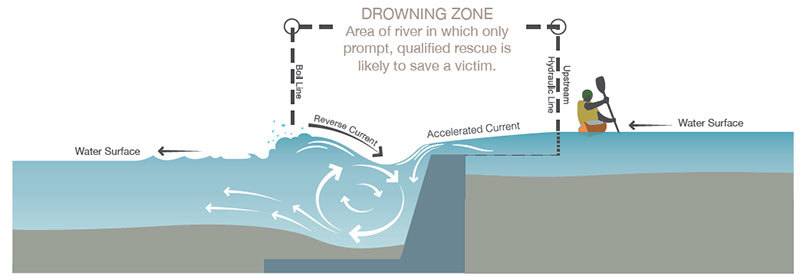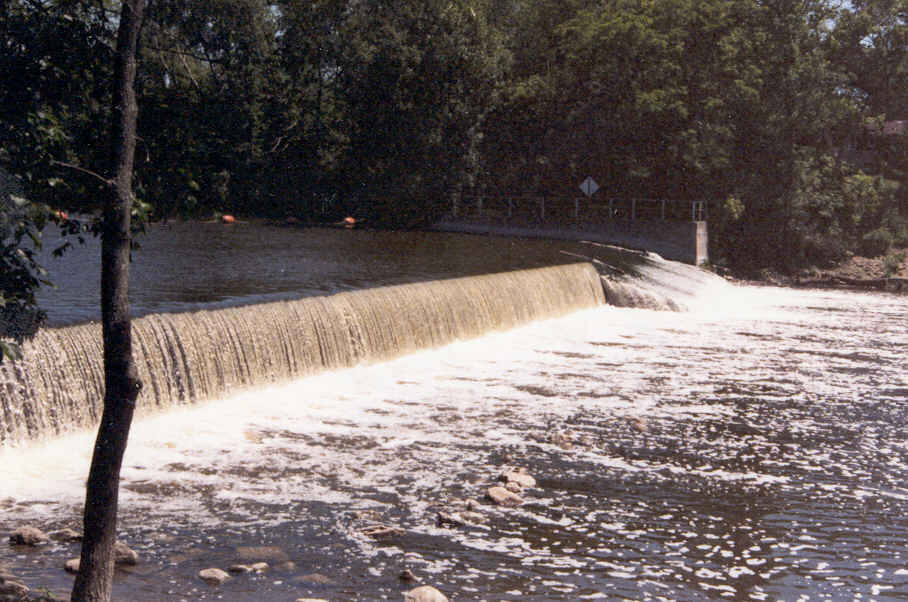|
Low-head dams, sometimes called run-of-river structures or simply weirs, are dams which usually span an entire river or stream and range in height from 1 to 15 feet. Historically, these dams have been built for a variety of purposes such as irrigation, mining, milling, water supply, and manufacturing. Due to the often-calm conditions, they can make an appealing spot for swimming, fishing, or even boating. But while these dams may appear harmless, their deceptive upstream and downstream conditions can pose a deadly hazard.
When approaching from upstream, low-head dams can be difficult to detect due to their height and the relatively peaceful pool. The lack of indicators combined with strong current above the dam can limit reaction time and boaters’ ability to safely exit the river upstream. Aside from the danger of going over a dam, flow transitions at low-head dams can create dangerous recirculating currents on the downstream side.
As objects pass over the dam they are forced underwater to the bottom, pushed away from the dam, circulated to the top, drawn back to the face of the dam, and then forced down again. This process also recirculates a lot of air, and the churning of water and air reduces buoyancy, making it harder to stay afloat and reducing the efficacy of any personal flotation devices. Heavy and dangerous debris can get trapped in this hydraulic and together with disorientation, the possibility of hypothermia, and reduced buoyancy, add to an already dangerous hydraulic condition. These nearly inescapable conditions are why low-head dams have earned the ominous nickname of “drowning machines”.
In engineering terms, as high velocity water flows over a dam and discharges to a calmer pool below, it transitions from supercritical to subcritical flow, forming a hydraulic jump. Hydraulic jumps are normally formed downstream of dams to dissipate energy and to return the flow to subcritical conditions. But when the tailwater rises and the hydraulic jump becomes submerged, it creates a dangerous recirculating current, or a hydraulic. When a hydraulic is present at the downstream face of low-head dams, debris or objects swept over the dam become trapped in these hydraulic ‘rollers’.
 This illustration by the Iowa Department of Natural Resources demonstrates a hydraulic which can be created at low-head dams.
It’s important to note that hazardous hydraulic conditions can occur at low-head dams of all sizes. On small rivers the force of the hydraulic can be strong enough to trap and pull you under water, even while wearing a personal flotation device. During periods of high water and heavy rainfall, the recirculating current can become stronger and its reach can extend even further downstream. Visually inspecting a low-head dam can provide clues as to whether the structure is generating a hydraulic, though the best safety measure is to always avoid dams. A key indicator is a boil zone, which can extend from a few feet in front of the dam to more than 100 feet below depending on the river. Boil zones have a white, frothy appearance and are usually higher than the water surrounding them. Another indicator is the presence of logs and debris bobbing up and down while trapped at the base of the dam.
Because of their seemingly harmless appearance, it’s important to understand not only the danger low-head dams pose, but also the measures which can help keep you safe when recreating near these dams. Since low-head dams can be difficult to spot, recreators on rivers or streams should always be alert for potentially dangerous situations and use the following tips to stay safe when enjoying Wisconsin’s waterways:
- Plan your trip ahead of time and check your route for potential dangers along the way.
- Use caution when recreating near dams.
- Be sure to obey any dam warning signs you see.
- Always portage around the dam when kayaking, canoeing, or tubing. Make sure that you re-enter the waterway well downstream of the boil.
- Never enter the water to try to help someone stuck in a hydraulic roller. Call 911 and use a remote assistive device such as a rope or throw bag to try and pull them back to safety.
- Always dress appropriately, making sure to wear a personal flotation device.
 Thiensville Dam, a low-head dam located in Ozaukee County. Since the photo was taken, improvements have been made to reduce the hydraulic roller effect.
|